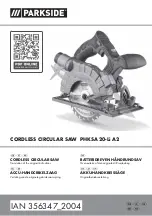
25
Blade not centered in saw cut
Blade centered in saw cut
6. Teeth set insufficient.
The set of the teeth is there to create a slot for the back of the blade to pass through. Ideally
the body of the blade should not touch the side of the job, but this is not practical, and the
best that we can hope for is that little pressure is caused on the blade. If the set is
insufficient, the blade will heat up as it rubs on the wood, and the cut will be slow, similar to
cutting with a dull blade.
7. Uneven sharpening of the teeth.
If the teeth are not ground evenly, the pressure during cutting will be different on the sides
of the blade, and the blade will follow the path of least resistance and wander.
8. Uneven set.
If the set of the teeth is not the same, the pressures will be different on the sides of the
blade, and the blade will follow the path of least resistance and wander.
9. Blade speed insufficient.
If the blade speed is too slow for the job at hand, the gullets will block with sawdust and
cause uneven pressures on the blade. This will cause blade to wander. To correct this, slow
the feed rate.
10. Blade drift.
Each blade has a natural cutting angle (drift). This is the angle that it will cut at and it may
not be square to the table. If you are using a fence as a guide to cut parallel, it will have to
be set to this cutting angle.
Adjusting the fence for drift.
Method 1.
1.
Make a straight pencil line on the edge of a board.
2.
Feed the wood into the blade, cutting next to the
pencil mark. If the blade is drifting, you will have to
compensate by angling the wood and that way keep
the cut straight.
3.
Stop the cut in the middle of the wood and mark
with a pencil the angle on the table. This is the angle
of drift, and you will have to set the fence to the
pencil line.
4.
To adjust the fence, loosen the clamp bolts that
attach the aluminum extrusion to the cast iron knuckle.
Move the aluminum extrusion so that it lines up with
the pencil mark on the table and re-tighten the clamp
screws.
Method 2 (Recommended).
1.
Set the fence parallel with the blade by loosening
the clamp screws that hold the aluminum extrusion to
the cast iron knuckle. It is not important that it is exact,
as you will be readjusting later in the procedure.
2.
Using a piece of scrap wood, make a cut while
holding the wood against the fence. Stop the cut in the
middle of the wood and stop the bandsaw.
3.
Look at the position of the back of the blade within the saw cut. The back of the blade
should be in the center of the slot, but you will probably find that it is closer to one side.
Содержание LT14 series
Страница 1: ...2072 Alton Parkway Irvine CA 92606 www lagunatools com 800 234 1976...
Страница 9: ...9 Screws etc Leveling bolts Allen keys Tool holder Mobility bracket...
Страница 47: ...47...
Страница 48: ...48...
Страница 49: ...49...
Страница 50: ...50...
Страница 51: ...51...
Страница 52: ...52...
Страница 53: ...53...
Страница 54: ...54...
















































